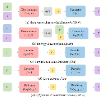Generative models, such as Variational Auto-Encoder (VAE) and Generative Adversarial Network (GAN), have been successfully applied in sequential recommendation. These methods require sampling from probability distributions and adopt auxiliary loss functions to optimize the model, which can capture the uncertainty of user behaviors and alleviate exposure bias. However, existing generative models still suffer from the posterior collapse problem or the model collapse problem, thus limiting their applications in sequential recommendation. To tackle the challenges mentioned above, we leverage a new paradigm of the generative models, i.e., diffusion models, and present sequential recommendation with diffusion models (DiffRec), which can avoid the issues of VAE- and GAN-based models and show better performance. While diffusion models are originally proposed to process continuous image data, we design an additional transition in the forward process together with a transition in the reverse process to enable the processing of the discrete recommendation data. We also design a different noising strategy that only noises the target item instead of the whole sequence, which is more suitable for sequential recommendation. Based on the modified diffusion process, we derive the objective function of our framework using a simplification technique and design a denoise sequential recommender to fulfill the objective function. As the lengthened diffusion steps substantially increase the time complexity, we propose an efficient training strategy and an efficient inference strategy to reduce training and inference cost and improve recommendation diversity. Extensive experiment results on three public benchmark datasets verify the effectiveness of our approach and show that DiffRec outperforms the state-of-the-art sequential recommendation models.
翻译:生成模型,如变分自编码器(VAE)和生成对抗网络(GAN),已成功应用于顺序推荐。这些方法要求从概率分布中进行采样,并采用辅助损失函数来优化模型,这可以捕捉用户行为的不确定性并减轻曝光偏差。然而,现有的生成模型仍然存在后验崩溃问题或模型崩溃问题,从而限制了它们在顺序推荐中的应用。为解决上述挑战,我们利用生成模型的一个新范例,即扩散模型,并提出了顺序推荐中的扩散模型(DiffRec),可以避免VAE和GAN模型的问题并显示出更好的性能。虽然扩散模型最初是用于处理连续的图像数据,但我们设计了额外的过渡来实现正向过程以及反向过程中的过渡,以实现离散推荐数据的处理。我们还设计了一种不同的噪声策略,仅对目标项进行噪声,而不是整个序列,这更适用于顺序推荐。基于修改后的扩散过程,我们使用简化技术导出了框架的目标函数,并设计了一个去噪的顺序推荐器来实现目标函数。由于延长的扩散步数极大地增加了时间复杂度,我们提出了一种高效的训练策略和一种高效的推断策略,以降低训练和推断成本并提高推荐多样性。在三个公共基准数据集上的广泛实验结果验证了我们方法的有效性,并显示DiffRec优于当前最先进的顺序推荐模型。




